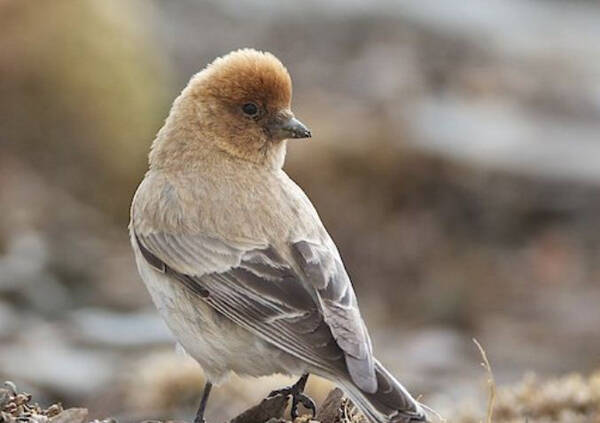Carpodacus sillemi
IUCN
LCBasic Information
Scientific classification
- name:Carpodacus sillemi
- Scientific Name:Carpodacus sillemi,Sillem's Rosefinch,White-rumped rosefinch, White-rumped ridgefinch, Red-headed ridgefinch, Salem rosefinch
- Outline:Songbird
- Family:Passeriformes Fringillidae Redfinch
Vital signs
- length:About 15 cm
- Weight:15-20g
- lifetime:No verification information
Feature
The head to the back of the neck is tea yellow and osmanthus red, and the back is dirty gray
Distribution and Habitat
The Brown-headed Redfinch was described from two specimens collected in 1929 from a barren plateau in the Xinjiang Autonomous Region of southern China at an altitude of 5,125 meters. One of the young birds collected had not yet fully grown wings, and the collectors believed that the birds either bred close to where they were collected or lived on nearby peaks in the Kunlun Mountains. It was rediscovered in 2012 1,350 kilometers away. Away from the Yeniugou area in the remote western Qinghai region of China, it was found again the following day in Yeniugou. In a 2013 survey, the species was not located anywhere outside of Yeniugou, and searches elsewhere failed to locate the species (2016). However, the survey did conclude that the species is difficult to find even at the right altitude (2014), so it is probably local and rare.
It inhabits alpine bare rock areas around 5,100 meters above sea level, preferring rocky, scree areas at high altitudes. It is a high-altitude mountain bird,
Appearance
Male: forehead, top of head, back of neck and sides of head are bright tea yellow cinnamon red or tea yellow brown, slightly lighter towards the back of neck, base of beak slightly stained with light yellowish leather. Back and shoulders are dirty gray, feather tips are stained with yellowish leather without vertical stripes, waist and tail upper coverts are grayish yellowish white, feathers are slightly stained with gray in the center. Tail is dark dirty gray, outer vanes and tiplets have wide white feather edges, on fresh feathers, feather edges are slightly stained with not very obvious pinkish leather yellow. Flight feathers are dark dirty gray, outer vanes have narrow, inconspicuous light dirty gray feather edges, outer 3 primary flight feathers have white but narrow and inconspicuous feather edges, secondary flight feathers and inner primary flight feathers have nearly white feather edges; upper wing coverts and tertiary flight feathers are dirty gray in the middle, base and midd
Details
Brown-headed Rosefinch, also known as Sillem's Rosefinch in English, is a small bird with no subspecies.

Similar species of Brown-headed Rosefinch, Alpine Sparrow, has a smoky gray forehead and head, and a rose-red waist. The lower body is light gray without cinnamon yellow. The difference between the two is obvious.
The Brown-headed Redfinch is a resident bird. It lives in pairs or family groups, and sometimes moves and forages with the Alpine Ridge Sparrow and the Brown-backed Snow Sparrow. It feeds on plant food such as fruits, seeds, inflorescences, buds, young leaves and stems. In the breeding season, it feeds mostly on insects, some weed seeds and plant branches and leaves, and in winter it feeds purely on plants, including wild plant seeds, barley, etc.
The Brown-headed Redfinch breeds between mid-June and August, just like other high-altitude passerines on the Qinghai-Tibet Plateau. Soon after arriving at the breeding grounds, they often begin to disperse into pairs. The male bird stands on the top branches of small trees or shrubs and sings. From time to time, it jumps and flies between the upper and lower branches, or flies from one tree to another nearby tree. The female bird flies to stand on the low branches or on the ground below the male bird. Mating also takes place on low branches or on the ground. Nests are built in thorny bushes such as roses and on small branches. Adult birds begin to molt in early September.
The availability of vegetation in the distribution area of the Brown-headed Red Finch varies with the seasons. Feathers that adult birds have replaced in September have been collected locally. This type of area is a barren plateau at an altitude of 5125 meters. The species observed in the Yeniugou Valley in 2012 and 2013 were between 4950-5007 meters above sea level. The 2012 and 2013 observations were made on moist, south-facing, low-slope slopes with abundant ground vegetation compared to other areas. This species feeds on this vegetation, so they may be restricted to these two areas where this vegetation density is sufficient.
Listed in the IUCN Red List of Threatened Species 2020 ver 3.1 - Not Determined (DD).
Listed in China's National Key Protected Wildlife List (February 5, 2021) Level II.
Protect wild animals and stop eating game.
Maintaining ecological balance is everyone's responsibility!








